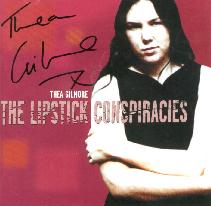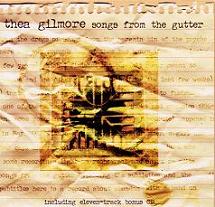

Thea Gilmore is someone else who won't need much of a build-up. She is of course Rod's 'significant other' for the purposes of that unforgettable duet on We Have to Talk from Stamping Ground.
Thea's relationship with Rod is on a strictly reciprocal footing. On The Lipstick Conspiracies, described by Rod as an 'album of potent contemporary songs', Rod played bass on some tracks, dobro on one, and electric slide on another.
Rod's precise track-by-track contribution can be detailed as follows:
Track 1. Generation Y? - Bass guitar, and vocals. Rod, as ever modest to a fault, recalls that he
'..."sang" in the Testosterone Chorus (all male participants without a valid excuse were obliged to chant the chorus, to mercifully inaudible effect).'
Track 2. Resurrection Men - Bass guitar
Track 5. Exit Route - Dobro.
Track 6. My Own Private Riot - Bass guitar
Track 7. Edge of My Seat - Bass guitar
Track 8. Bulletin Britain - Bass guitar (fretless this time!)
Track 10. Lidocaine Baby - Bass guitar
Track 11. Land of the Free - Bass & electric slide
Of the remainder of the twelve tracks, two had no bass, and the other two, plus Exit Route, featured Johnny Bridgewood on double bass.

2002 Songs from the Gutter
Songs from the Gutter, Thea Gilmore's 'between albums album' of songs from her personal Cutting Room Floor, was recorded in 2002 at Revolution Studios in Cheadle Hulme, Cheshire by a core team of Thea, Nigel Stonier (bass & production), Robbie McIntosh (guitars) and Paul Beavis (drums). On May 27th this line-up was augmented by the addition of Rod on a couple of tracks. Both were recorded live, with Rod's presence enabling Nigel to maintain a watchful ear from the safety of the control-room.
The three-chord stormer Heart String Blues has Rod playing Nigel's Fender bass, while the bass-free, country-blues jam Mud on My Shoes features Rod on Dobro and adding his voice to the impromptu chorus that was overdubbed immediately afterwards.
The CD notes, written by Thea, state that 'Rod Clements joined in on a couple and lent me the pandemonium'. This cryptic acknowledgement refers to Rod's Casiotone electronic keyboard-cum-rhythm box which is building up quite a discography of its own, from Lindisfarne's Amigos album of 1988 to Stamping Ground when it was played by Nigel and credited as a harmonium. Songs from the Gutter, however, is the highest point in its career to date, as it is the first instrument heard on the album (on Down to Nowhere), providing simultaneously the famous Casio 'crisp-packet-trapped-in-grandfather-clock' drumbeat, the funereal bass-line and the cheesy-weedy automated arpeggio - all at the touch of a button. Despised for years as a cheap toy, its qualities are finally being recognised and Rod's faith in it vindicated.
Incidentally, Nigel and Thea sometimes use on stage (and give due credit for) another instrument from the Clements collection - a red and white (eat your hearts out, White Stripes) plastic melodica or blow-through keyboard.
Home